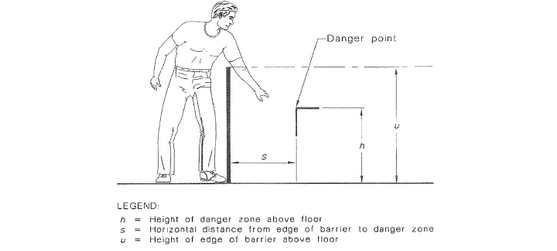


Mine Health and Safety Act, 1996 (Act No. 29 of 1996)RegulationsGuideline for a Mandatory Code of PracticeSafe Use of Conveyor Belt Installations for the Transportation of Mineral, Material or PersonnelAnnexuresAnnexure C: Ergonomic Data - extracts from to AS1755-2000 (Normative)C3 Upper Limb Reach Distance with Fixed Fences |
C3.1 General
Selection of the appropriate safety distance for reaching over a fixed fence shall depend on a risk assessment. The assessment shall be based on the probability of occurrence of injury and the likely severity of that injury.
C3.2 Reaching down and over
When reaching down over an edge, e.g. on machine frames or barriers, the safety distance is found from Figure C2.
NOTE: Attention is drawn to the increased danger of overbalancing when reaching over a lm high barrier |

Height of danger zone (h) |
Horizontal distance to danger zone (s) |
||||||||
Height of protective structure (u)* |
|||||||||
1 000† |
1 200† |
1 400† |
1 600† |
1 800 |
2 000 |
2 200 |
2 400 |
2 500 |
|
2 500 |
— |
— |
— |
— |
— |
— |
— |
— |
— |
2 400 |
100 |
100 |
100 |
100 |
100 |
100 |
100 |
100 |
— |
2 200 |
600 |
600 |
500 |
500 |
400 |
350 |
250 |
— |
— |
2 000 |
1 100 |
900 |
700 |
600 |
500 |
350 |
— |
— |
— |
1 800 |
1 100 |
1 000 |
900 |
900 |
600 |
— |
— |
— |
— |
1 600 |
1 300 |
1 000 |
900 |
900 |
500 |
— |
— |
— |
— |
1 400 |
1 300 |
1 000 |
900 |
800 |
100 |
— |
— |
— |
— |
1 200 |
1 400 |
1 000 |
900 |
500 |
— |
— |
— |
— |
— |
1 000 |
1 400 |
1 000 |
900 |
300 |
— |
— |
— |
— |
— |
800 |
1 300 |
900 |
600 |
— |
— |
— |
— |
— |
— |
600 |
1 200 |
500 |
— |
— |
— |
— |
— |
— |
— |
400 |
1 200 |
300 |
— |
— |
— |
— |
— |
— |
— |
200 |
1 100 |
200 |
— |
— |
— |
— |
— |
— |
— |
0 |
1 100 |
200 |
— |
— |
— |
— |
— |
— |
— |
FIGURE C2: Guard distances
| * | Protective structures less than 1000 mm height are not included because they do not sufficiently restrict movement of the body. |
| † | Protective structures having a height of 1600 mm and less should only be used where a risk assessment indicates low probability and low severity of injury. |
NOTE: 1) There shall be no interpolation of the values in the Table. 2) Barriers are not foolproof and they cannot prevent access to persons intent on gaining access. Therefore, as a person's intent on reaching a dangerous part increases, e.g. by climbing on chairs, ladders or the barrier itself, the protection provided by a barrier decreases.
|
C3.3 Reaching under
Where clearance is provided under a guard for cleaning spillages, swarf and similar, the clearance shall not exceed 200 mm. (See also Figure C3.)